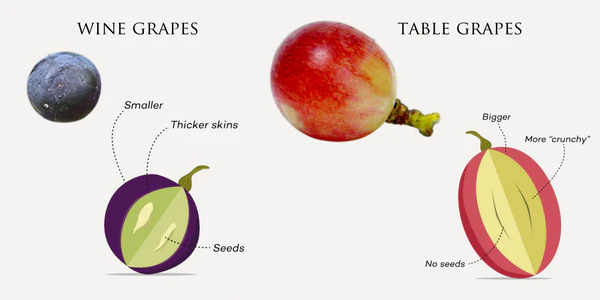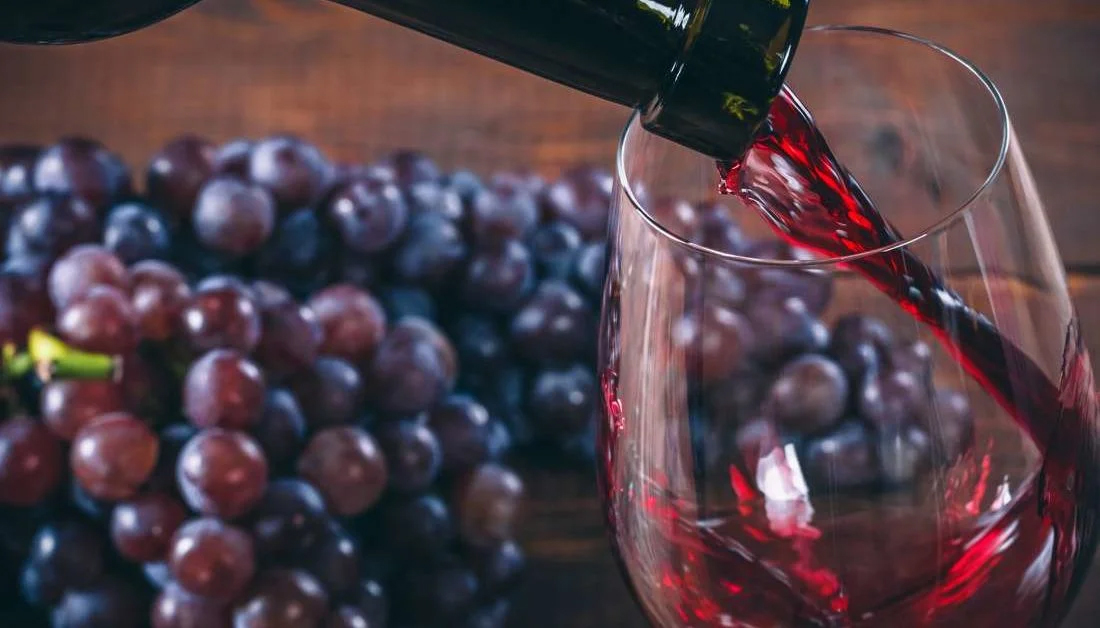Wine is one of the oldest and most beloved beverages in the world. Crafted from a variety of grapes, each varietal bring unique flavors, aromas, and characteristics to the bottle. While thousands of grapes exist, only a few dominate vineyards and wine lists worldwide. But not all grapes are suitable for winemaking—there are key differences between table grapes and wine grapes.
Table Grapes vs. Wine Grapes

Grapes used for winemaking belong to the species Vitis vinifera, which includes nearly all of the world’s classic wine grapes like Cabernet Sauvignon, Chardonnay, and Pinot Noir. These grapes differ significantly from the table grapes commonly found in grocery stores:
- Smaller Size – Wine grapes are typically smaller than table grapes, which helps concentrate their flavors.
- Thicker Skins – The skins of wine grapes contain tannins and pigments that contribute to a wine’s structure and color, while table grapes have thinner skins for easier eating.
- Higher Sugar Content – Wine grapes have more natural sugars, which are essential for fermentation into alcohol.
- Balanced Acidity – The acidity in wine grapes is crucial for achieving balance and complexity in the final wine, whereas table grapes are often bred for sweetness with less emphasis on acidity.
- Seeds – Most wine grapes have seeds, which contribute tannins to the wine, whereas many table grapes are seedless for convenience.
Common Vitis Vinifera Wine Grapes
Red Wine Grapes
- Cabernet Sauvignon – One of the most popular red wine grapes, Cabernet Sauvignon is known for its bold flavors, high tannins, and aging potential. It often features notes of blackcurrant, cedar, and green bell pepper.
- Merlot – Softer and more approachable than Cabernet, Merlot boasts flavors of plum, black cherry, and chocolate, making it a great choice for both new and seasoned wine drinkers.
- Pinot Noir – This delicate grape is prized for its light body, silky tannins, and complex flavors of red berries, earth, and spice. It thrives in cooler climates like Burgundy and Oregon.
- Syrah/Shiraz – Known as Syrah in France and Shiraz in Australia, this grape produces bold, spicy wines with flavors of blackberry, pepper, and smoked meat.
- Zinfandel – A staple of California winemaking, Zinfandel delivers jammy fruit flavors, spice, and a rich mouthfeel. It’s also used to produce the popular White Zinfandel rosé.
White Wine Grapes
- Chardonnay – A versatile grape that can range from crisp and citrusy to rich and buttery, depending on how it’s made. Chardonnay is a key player in both still and sparkling wines.
- Sauvignon Blanc – Known for its zesty acidity and herbaceous notes, Sauvignon Blanc often displays flavors of lime, green apple, and grass. It thrives in regions like New Zealand and the Loire Valley.
- Riesling – This aromatic white grape is famous for its high acidity and range of sweetness levels, offering flavors of stone fruit, honey, and petrol.
- Pinot Grigio/Pinot Gris – Called Pinot Grigio in Italy and Pinot Gris in France, this grape produces refreshing, light-bodied wines with notes of pear, apple, and citrus.
- Gewürztraminer – A floral and aromatic grape known for its exotic spice, lychee, and rose petal aromas. It’s often made in an off-dry or slightly sweet style.
Other Grape Species Used in Winemaking
While Vitis vinifera is the dominant species, other grape species are also used in winemaking, particularly in North America and for hybrid wines:
- Vitis labrusca – Native to North America, this species includes grapes like Concord and Niagara. These grapes have a distinct “foxy” aroma and are often used for juice, jelly, and some sweeter wines.
- Vitis riparia – Found in the wild across North America, Vitis riparia is primarily used as rootstock for Vitis vinifera vines due to its resistance to pests like phylloxera.
- Vitis rotundifolia (Muscadine) – Native to the southeastern U.S., Muscadine grapes like Scuppernong are used to produce uniquely sweet and robust wines.
- Hybrid Grapes – Crosses between Vitis vinifera and North American species, hybrids like Vidal Blanc, Seyval Blanc, and Chambourcin are designed to withstand colder climates and disease pressures while still producing high-quality wine.
Each Vitis vinifera grape variety brings its own personality to the winemaking process. Factors like climate, soil, and winemaking techniques all influence the fruit. Whether you prefer a bold red, a crisp white, or something in between, there’s a grape variety—and a wine—for everyone. Cheers!



